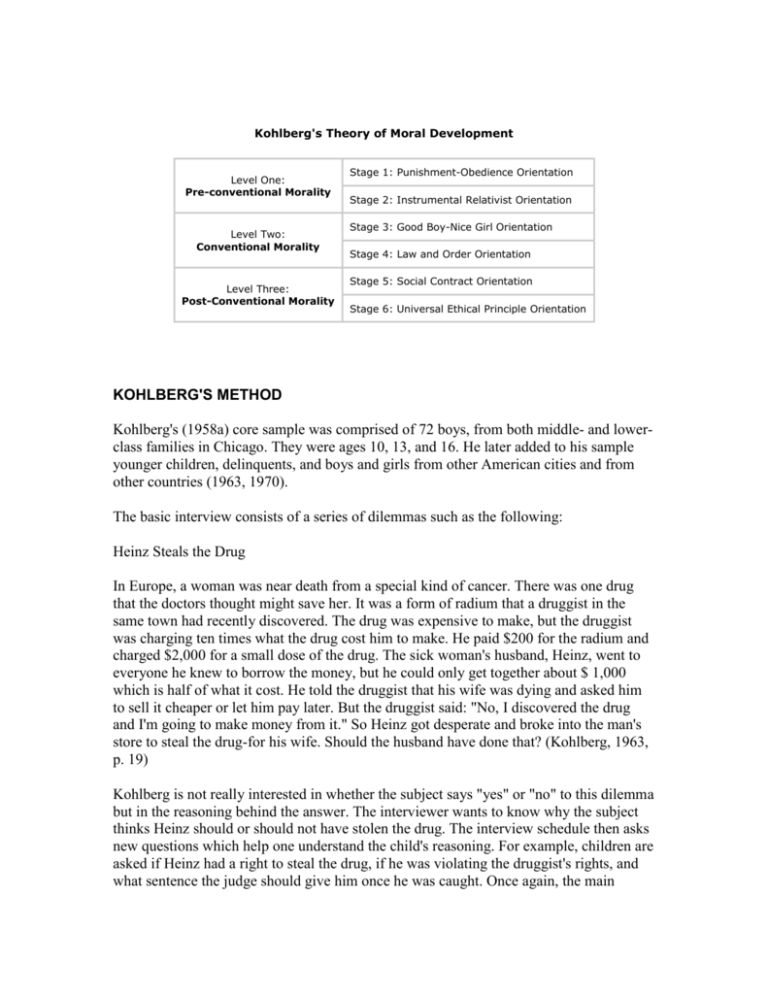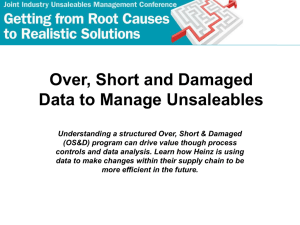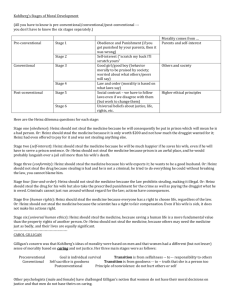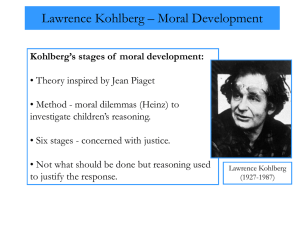Kohlberg`s Moral Development
advertisement

Kohlberg's Theory of Moral Development Level One: Pre-conventional Morality Level Two: Conventional Morality Level Three: Post-Conventional Morality Stage 1: Punishment-Obedience Orientation Stage 2: Instrumental Relativist Orientation Stage 3: Good Boy-Nice Girl Orientation Stage 4: Law and Order Orientation Stage 5: Social Contract Orientation Stage 6: Universal Ethical Principle Orientation KOHLBERG'S METHOD Kohlberg's (1958a) core sample was comprised of 72 boys, from both middle- and lowerclass families in Chicago. They were ages 10, 13, and 16. He later added to his sample younger children, delinquents, and boys and girls from other American cities and from other countries (1963, 1970). The basic interview consists of a series of dilemmas such as the following: Heinz Steals the Drug In Europe, a woman was near death from a special kind of cancer. There was one drug that the doctors thought might save her. It was a form of radium that a druggist in the same town had recently discovered. The drug was expensive to make, but the druggist was charging ten times what the drug cost him to make. He paid $200 for the radium and charged $2,000 for a small dose of the drug. The sick woman's husband, Heinz, went to everyone he knew to borrow the money, but he could only get together about $ 1,000 which is half of what it cost. He told the druggist that his wife was dying and asked him to sell it cheaper or let him pay later. But the druggist said: "No, I discovered the drug and I'm going to make money from it." So Heinz got desperate and broke into the man's store to steal the drug-for his wife. Should the husband have done that? (Kohlberg, 1963, p. 19) Kohlberg is not really interested in whether the subject says "yes" or "no" to this dilemma but in the reasoning behind the answer. The interviewer wants to know why the subject thinks Heinz should or should not have stolen the drug. The interview schedule then asks new questions which help one understand the child's reasoning. For example, children are asked if Heinz had a right to steal the drug, if he was violating the druggist's rights, and what sentence the judge should give him once he was caught. Once again, the main concern is with the reasoning behind the answers. The interview then goes on to give more dilemmas in order to get a good sampling of a subject's moral thinking. Once Kohlberg had classified the various responses into stages, he wanted to know whether his classification was reliable. In particular, he. wanted to know if others would score the protocols in the same way. Other judges independently scored a sample of responses, and he calculated the degree to which all raters agreed. This procedure is called interrater reliability. Kohlberg found these agreements to be high, as he has in his subsequent work, but whenever investigators use Kohlberg's interview, they also should check for interrater reliability before scoring the entire sample. KOHLBERG'S SIX STAGES Level 1. Preconventional Morality The first level of moral thinking is that generally found at the elementary school level. In the first stage of this level, people behave according to socially acceptable norms because they are told to do so by some authority figure (e.g., parent or teacher). This obedience is compelled by the threat or application of punishment. The second stage of this level is characterized by a view that right behavior means acting in one's own best interests. I. Preconventional Level At this level, the child is responsive to cultural rules and labels of good and bad, right or wrong, but he interprets the labels in terms of either the physical or hedonistic consequences of action (punishment, reward, exchange of favors) or the physical power of those who enunciate the rules and labels. The level is divided into the following three stages: Stage 0: Egocentric judgment. The child makes judgments of good on the basis of what he likes and wants or what helps him, and bad on the basis of what he does not like or what hurts him. He has no concept of rules or of obligations to obey or conform independent of his wish. Stage 1: The punishment and obedience orientation. The physical consequences of action determine its goodness or badness regardless of the human meaning or value of these consequences. Avoidance of punishment and unquestioning deference to power are values in their own right, not in terms of respect for an underlying moral order supported by punishment and authority (the latter is stage 4). Stage 2: The instrumental relativist orientation. Right action consists of what instrumentally satisfies one's own needs and occasionally the needs of others. Human relations are viewed in terms such as those of the market place. Elements of fairness, reciprocity, and equal sharing are present, but they are always interpreted in a physical, pragmatic way. Reciprocity is a matter of "you scratch my back and I'll scratch your", not loyalty, gratitude, or justice. Stage 1. Obedience and Punishment Orientation. Kohlberg's stage 1 is similar to Piaget's first stage of moral thought. The child assumes that powerful authorities hand down a fixed set of rules which he or she must unquestioningly obey. To the Heinz dilemma, the child typically says that Heinz was wrong to steal the drug because "It's against the law," or "It's bad to steal," as if this were all there were to it. When asked to elaborate, the child usually responds in terms of the consequences involved, explaining that stealing is bad "because you'll get punished" (Kohlberg, 1958b). Although the vast majority of children at stage 1 oppose Heinz’s theft, it is still possible for a child to support the action and still employ stage 1 reasoning. For example, a child might say, "Heinz can steal it because he asked first and it's not like he stole something big; he won't get punished" (see Rest, 1973). Even though the child agrees with Heinz’s action, the reasoning is still stage 1; the concern is with what authorities permit and punish. Kohlberg calls stage 1 thinking "preconventional" because children do not yet speak as members of society. Instead, they see morality as something external to themselves, as that which the big people say they must do. Stage 2. Individualism and Exchange. At this stage children recognize that there is not just one right view that is handed down by the authorities. Different individuals have different viewpoints. "Heinz," they might point out, "might think it's right to take the drug, the druggist would not." Since everything is relative, each person is free to pursue his or her individual interests. One boy said that Heinz might steal the drug if he wanted his wife to live, but that he doesn't have to if he wants to marry someone younger and better-looking (Kohlberg, 1963, p. 24). Another boy said Heinz might steal it because maybe they had children and he might need someone at home to look after them. But maybe he shouldn't steal it because they might put him in prison for more years than he could stand. (Colby and Kauffman. 1983, p. 300) What is right for Heinz, then, is what meets his own self-interests. You might have noticed that children at both stages 1 and 2 talk about punishment. However, they perceive it differently. At stage 1 punishment is tied up in the child's mind with wrongness; punishment "proves" that disobedience is wrong. At stage 2, in contrast, punishment is simply a risk that one naturally wants to avoid. Although stage 2 respondents sometimes sound amoral, they do have some sense of right action. This is a notion of fair exchange or fair deals. The philosophy is one of returning favors--"If you scratch my back, I'll scratch yours." To the Heinz story, subjects often say that Heinz was right to steal the drug because the druggist was unwilling to make a fair deal; he was "trying to rip Heinz off," Or they might say that he should steal for his wife "because she might return the favor some day" (Gibbs et al., 1983, p. 19). Respondents at stage 2 are still said to reason at the preconventional level because they speak as isolated individuals rather than as members of society. They see individuals exchanging favors, but there is still no identification with the values of the family or community. Level II. Conventional Morality The second level of moral thinking is that generally found in society, hence the name "conventional." The first stage of this level (stage 3) is characterized by an attitude which seeks to do what will gain the approval of others. The second stage is one oriented to abiding by the law and responding to the obligations of duty. II. Conventional Level At this level, the individual perceives the maintenance of the expectations of his family, group, or nation as valuable in its own right, regardless of immediate and obvious consequences. The attitude is not only one of conformity to personal expectations and social order, but of loyalty to it, of actively maintaining, supporting, and justifying the order and identifying with the persons or group involved in it. The level consists of the following two stages: Stage 3: The interpersonal concordance or "good boy-nice girl" orientation. Good behavior is what pleases or helps others and is approved by them. There is much conformity to stereotypical images of what is majority or "natural" behavior. Behavior is frequently judged by intention -- "he means well" becomes important for the first time. One earns approval by being "nice". Stage 4: The "law and order" orientation. The individual is oriented toward authority, fixed rules, and the maintenance of the social order. Right behavior consists in doing one's duty, showing respect for authority, and maintaining the given social order for its own sake. Stage 3. Good Interpersonal Relationships. At this stage children--who are by now usually entering their teens--see morality as more than simple deals. They believe that people should live up to the expectations of the family and community and behave in "good" ways. Good behavior means having good motives and interpersonal feelings such as love, empathy, trust, and concern for others. Heinz, they typically argue, was right to steal the drug because "He was a good man for wanting to save her," and "His intentions were good, that of saving the life of someone he loves." Even if Heinz doesn't love his wife, these subjects often say, he should steal the drug because "I don't think any husband should sit back and watch his wife die" (Gibbs et al., 1983, pp. 36-42; Kohlberg, 1958b). If Heinz’s motives were good, the druggist's were bad. The druggist, stage 3 subjects emphasize, was "selfish," "greedy," and "only interested in himself, not another life." Sometimes the respondents become so angry with the druggist that they say that he ought to be put in jail (Gibbs et al., 1983, pp. 26-29, 40-42). A typical stage 3 response is that of Don, age 13: It was really the druggist's fault, he was unfair, trying to overcharge and letting someone die. Heinz loved his wife and wanted to save her. I think anyone would. I don't think they would put him in jail. The judge would look at all sides, and see that the druggist was charging too much. (Kohlberg, 1963, p. 25) We see that Don defines the issue in terms of the actors' character traits and motives. He talks about the loving husband, the unfair druggist, and the understanding judge. His answer deserves the label "conventional "morality" because it assumes that the attitude expressed would be shared by the entire community—"anyone" would be right to do what Heinz did (Kohlberg, 1963, p. 25). As mentioned earlier, there are similarities between Kohlberg's first three stages and Piaget's two stages. In both sequences there is a shift from unquestioning obedience to a relativistic outlook and to a concern for good motives. For Kohlberg, however, these shifts occur in three stages rather than two. Stage 4. Maintaining the Social Order. Stage 3 reasoning works best in two-person relationships with family members or close friends, where one can make a real effort to get to know the other's feelings and needs and try to help. At stage 4, in contrast, the respondent becomes more broadly concerned with society as a whole. Now the emphasis is on obeying laws, respecting authority, and performing one's duties so that the social order is maintained. In response to the Heinz story, many subjects say they understand that Heinz's motives were good, but they cannot condone the theft. What would happen if we all started breaking the laws whenever we felt we had a good reason? The result would be chaos; society couldn't function. As one subject explained, I don't want to sound like Spiro Agnew, law and order and wave the flag, but if everybody did as he wanted to do, set up his own beliefs as to right and wrong, then I think you would have chaos. The only thing I think we have in civilization nowadays is some sort of legal structure which people are sort of bound to follow. [Society needs] a centralizing framework. (Gibbs et al., 1983, pp. 140-41) Because stage 4, subjects make moral decisions from the perspective of society as a whole, they think from a full-fledged member-of-society perspective (Colby and Kohlberg, 1983, p. 27). You will recall that stage 1 children also generally oppose stealing because it breaks the law. Superficially, stage 1 and stage 4 subjects are giving the same response, so we see here why Kohlberg insists that we must probe into the reasoning behind the overt response. Stage 1 children say, "It's wrong to steal" and "It's against the law," but they cannot elaborate any further, except to say that stealing can get a person jailed. Stage 4 respondents, in contrast, have a conception of the function of laws for society as a whole--a conception which far exceeds the grasp of the younger child. Level III. Postconventional Morality The third level of moral thinking is one that Kohlberg felt is not reached by the majority of adults. Its first stage (stage 5) is an understanding of social mutuality and a genuine interest in the welfare of others. The last stage (stage 6) is based on respect for universal principle and the demands of individual conscience. While Kohlberg always believed in the existence of Stage 6 and had some nominees for it, he could never get enough subjects to define it, much less observe their longitudinal movement to it. III. Post-Conventional, Autonomous, or Principled Level. The individual makes a clear effort to define moral values and principles that have validity and application apart from the authority of the groups of persons holding them and apart from the individual's own identification with the group. The level has the two following stages: Stage 5: The social-contract legalistic orientation (generally with utilitarian overtones). Right action tends to be defined in terms of general individual rights and standards that have been critically examined and agreed upon by the whole society. There is a clear awareness of the relativism of personal values and opinions and a corresponding emphasis upon procedural rules for reaching consensus. Aside from what is constitutionally and democratically agreed upon, right action is a matter of personal values and opinions. The result is an emphasis upon the "legal point of view", but with an additional emphasis upon the possibility of changing the law in terms of rational considerations of social utility (rather than freezing it in terms of stage 4 "law and order"). Outside the legal realm, free agreement, and contract, is the binding element of obligation. The "official" morality of the American government and Constitution is at this stage. Stage 6: The universal ethical-principle orientation. Right is defined by the decision of conscience in accord with self-chosen ethical principles that appeal to logical comprehensiveness, universality, and consistency. These principles are abstract and ethical (the Golden Rule, the categorical imperative); they are not concrete moral rules like the Ten Commandments. At heart, these are universal principles of justice, of the reciprocity and equality of the human rights, and of respect for the dignity of human beings as individual persons. Stage 5. Social Contract and Individual Rights. At stage 4, people want to keep society functioning. However, a smoothly functioning society is not necessarily a good one. A totalitarian society might be well-organized, but it is hardly the moral ideal. At stage 5, people begin to ask, "What makes for a good society?" They begin to think about society in a very theoretical way, stepping back from their own society and considering the rights and values that a society ought to uphold. They then evaluate existing societies in terms of these prior considerations. They are said to take a "prior-to-society" perspective (Colby and Kohlberg, 1983, p. 22). Stage 5 respondents basically believe that a good society is best conceived as a social contract into which people freely enter to work toward the benefit of all They recognize that different social groups within a society will have different values, but they believe that all rational people would agree on two points. First they would all want certain basic rights, such as liberty and life, to be protected Second, they would want some democratic procedures for changing unfair law and for improving society. In response to the Heinz dilemma, stage 5 respondents make it clear that they do not generally favor breaking laws; laws are social contracts that we agree to uphold until we can change them by democratic means. Nevertheless, the wife’s right to live is a moral right that must be protected. Thus, stage 5 respondent sometimes defend Heinz’s theft in strong language: It is the husband's duty to save his wife. The fact that her life is in danger transcends every other standard you might use to judge his action. Life is more important than property. This young man went on to say that "from a moral standpoint" Heinz should save the life of even a stranger, since to be consistent, the value of a life means any life. When asked if the judge should punish Heinz, he replied: Usually the moral and legal standpoints coincide. Here they conflict. The judge should weight the moral standpoint more heavily but preserve the legal law in punishing Heinz lightly. (Kohlberg, 1976, p. 38) Stage 5 subjects,- then, talk about "morality" and "rights" that take some priority over particular laws. Kohlberg insists, however, that we do not judge people to be at stage 5 merely from their verbal labels. We need to look at their social perspective and mode of reasoning. At stage 4, too, subjects frequently talk about the "right to life," but for them this right is legitimized by the authority of their social or religious group (e.g., by the Bible). Presumably, if their group valued property over life, they would too. At stage 5, in contrast, people are making more of an independent effort to think out what any society ought to value. They often reason, for example, that property has little meaning without life. They are trying to determine logically what a society ought to be like (Kohlberg, 1981, pp. 21-22; Gibbs et al., 1983, p. 83). Stage 6: Universal Principles. Stage 5 respondents are working toward a conception of the good society. They suggest that we need to (a) protect certain individual rights and (b) settle disputes through democratic processes. However, democratic processes alone do not always result in outcomes that we intuitively sense are just. A majority, for example, may vote for a law that hinders a minority. Thus, Kohlberg believes that there must be a higher stage--stage 6--which defines the principles by which we achieve justice. Kohlberg's conception of justice follows that of the philosophers Kant and Rawls, as well as great moral leaders such as Gandhi and Martin Luther King. According to these people, the principles of justice require us to treat the claims of all parties in an impartial manner, respecting the basic dignity, of all people as individuals. The principles of justice are therefore universal; they apply to all. Thus, for example, we would not vote for a law that aids some people but hurts others. The principles of justice guide us toward decisions based on an equal respect for all. In actual practice, Kohlberg says, we can reach just decisions by looking at a situation through one another's eyes. In the Heinz dilemma, this would mean that all parties--the druggist, Heinz, and his wife--take the roles of the others. To do this in an impartial manner, people can assume a "veil of ignorance" (Rawls, 1971), acting as if they do not know which role they will eventually occupy. If the druggist did this, even he would recognize that life must take priority over property; for he wouldn't want to risk finding himself in the wife's shoes with property valued over life. Thus, they would all agree that the wife must be saved--this would be the fair solution. Such a solution, we must note, requires not only impartiality, but the principle that everyone is given full and equal respect. If the wife were considered of less value than the others, a just solution could not be reached. Until recently, Kohlberg had been scoring some of his subjects at stage 6, but he has temporarily stopped doing so, For one thing, he and other researchers had not been finding subjects who consistently reasoned at this stage. Also, Kohlberg has concluded that his interview dilemmas are not useful for distinguishing between stage 5 and stage 6 thinking. He believes that stage 6 has a clearer and broader conception of universal principles (which include justice as well as individual rights), but feels that his interview fails to draw out this broader understanding. Consequently, he has temporarily dropped stage 6 from his scoring manual, calling it a "theoretical stage" and scoring all postconventional responses as stage 5 (Colby and Kohlberg, 1983, p. 28). Theoretically, one issue that distinguishes stage 5 from stage 6 is civil disobedience. Stage 5 would be more hesitant to endorse civil disobedience because of its commitment to the social contract and to changing laws through democratic agreements. Only when an individual right is clearly at stake does violating the law seem justified. At stage 6, in contrast, a commitment to justice makes the rationale for civil disobedience stronger and broader. Martin Luther King, for example, argued that laws are only valid insofar as they are grounded in justice, and that a commitment to justice carries with it an obligation to disobey unjust laws. King also recognized, of course, the general need for laws and democratic processes (stages 4 and 5), and he was therefore willing to accept the penalities for his actions. Nevertheless, he believed that the higher principle of justice required civil disobedience (Kohlberg, 198 1, p. 43). Summary At stage 1 children think of what is right as that which authority says is right. Doing the right thing is obeying authority and avoiding punishment. At stage 2, children are no longer so impressed by any single authority; they see that there are different sides to any issue. Since everything is relative, one is free to pursue one's own interests, although it is often useful to make deals and exchange favors with others. At stages 3 and 4, young people think as members of the conventional society with its values, norms, and expectations. At stage 3, they emphasize being a good person, which basically means having helpful motives toward people close to one At stage 4, the concern shifts toward obeying laws to maintain society as a whole. At stages 5 and 6 people are less concerned with maintaining society for it own sake, and more concerned with the principles and values that make for a good society. At stage 5 they emphasize basic rights and the democratic processes that give everyone a say, and at stage 6 they define the principles by which agreement will be most just. The Heinz Dilemma 1. Scenario 1 A woman was near death from a unique kind of cancer. There is a drug that might save her. The drug costs $4,000 per dosage. The sick woman's husband, Heinz, went to everyone he knew to borrow the money and tried every legal means, but he could only get together about $2,000. He asked the doctor scientist who discovered the drug for a discount or let him pay later. But the doctor scientist refused. Should Heinz break into the laboratory to steal the drug for his wife? Why or why not? 2. Scenario 2 Heinz broke into the laboratory and stole the drug. The next day, the newspapers reported the break-in and theft. Brown, a police officer and a friend of Heinz remembered seeing Heinz last evening, behaving suspiciously near the laboratory. Later that night, he saw Heinz running away from the laboratory. Should Brown report what he saw? Why or why not? 3. Scenario 3 Officer Brown reported what he saw. Heinz was arrested and brought to court. If convicted, he faces up to two years' jail. Heinz was found guilty. Should the judge sentence Heinz to prison? Why or why not? Movement through the Stages Kohlberg's theory of moral reasoning is a stage theory. In other words, everyone goes through the stages sequentially without skipping any stage. However, movement through these stages are not natural, that is people do not automatically move from one stage to the next as they mature. In stage development, movement is effected when cognitive dissonance occurs ... that is when a person notices inadequacies in his or her present way of coping with a given moral dilemma. But according to stage theory, people cannot understand moral reasoning more than one stage ahead of their own. For example, a person in Stage 1 can understand Stage 2 reasoning but nothing beyond that. Therefore, we should present moral arguments that are only one stage ahead of a person's present level of reasoning to stimulate movement to higher stages. Stage 1: Punishment-Obedience Orientation Lawrence Kohlberg: "Physical consequences of an action determine its goodness or badness regardless of the human meaning or value of these consequences. Avoidance of punishment and unquestioning deference to power are valued in their own right, not in terms of respect for an underlying moral order supported by punishment and authority." (Duska, R. and Whelan, M., 1975) Summary: The concern is for self - "Will I get into trouble for doing (or not doing) it?" Good behaviour is associated with avoiding punishment. Possible Stage 1 responses to Heinz Dilemma: Heinz should not steal the drug because he might be caught and sent to jail. Heinz should steal the drug because if he doesn't then his wife might scold him. Note: Opposite responses could be given at each stage or different reasons could be given for the same response. Inadequacy of Stage 1 reasoning: Avoidance of punishment regardless of the ethical value of the actions is unhealthy especially under "bad" authorities such as Adolf Hitler. From 1933-45, Nazi soldiers persecuted Jews and other minorities. These soldiers either were carrying out orders under threat of punishment or had a misplaced trust in their leader. Another example of Stage 1 reasoning is a victim's fear of reporting sexual abuse because the perpetrator is a person in authority and had threatened to punish her if she did. How would you use the person's understanding of moral reasoning (Stages 1 and 2) to encourage her to report the abuse? Stage 2: Instrumental Relativist Orientation Lawrence Kohlberg: Right action is "that which instrumentally satisfies one's own needs and occasionally the needs of others." "Human relations are viewed in terms like those of the marketplace; elements of fairness, reciprocity and equal sharing are present, but they are always interpreted in a physical or pragmatic way. Reciprocity is a matter of 'you scratch my back and I'll scratch yours,' not of loyalty, gratitude or justice." (Duska, R. and Whelan, M., 1975) Summary: The concern is "What's in it for me?" Still egocentric in outlook but with a growing ability to see things from another person's perspective. Action is judged right if it helps in satisfying one's needs or involves a fair exchange. Possible Stage 2 responses to Heinz Dilemma: It is right for Heinz to steal the drug because it can cure his wife and then she can cook for him. The doctor scientist had spent lots of money and many years of his life to develop the cure so it's not fair to him if Heinz stole the drug. Inadequacy of Stage 2 reasoning: Heinz' need to have the drug to save his wife conflicts with the doctor scientist's need to make a profit from his research. A modern day equivalent is the issue of software piracy in the homes pitching the need of individuals to pick up IT skills against software developers' need to make a profit. Where the needs of different individuals conflict, can there ever be a fair exchange? Doesn't this conflict call for sacrifice from one of the parties? Stage 3: Good Boy-Nice Girl Orientation Lawrence Kohlberg: "Good behavior is that which pleases or helps others and is approved by them. There is much conformity to stereotypical images of what is majority or 'natural' behaviour. Behavior is frequently judged by intention. 'He means well' becomes important for the first time. One earns approval by being 'nice.'" (Duska, R. and Whelan, M., 1975) Summary: The concern is "What will people think of me?" and the desire is for group approval. Right action is one that would please or impress others. This often involves self-sacrifice but it provides the psychological pleasure of 'approval of others.' Actions are also judged in relation to their intention. Possible Stage 3 responses to Heinz Dilemma: Yes, Heinz should steal the drug. He probably will go to jail for a short time for stealing but his in-laws will think he is a good husband. Brown, the police officer should report that he saw Heinz behaving suspiciously and running away from the laboratory because his boss would be pleased. [ See Scenario 2 of Heinz Dilemma ] Officer Brown should not report what he saw because his friend Heinz would be pleased. The judge should not sentence Heinz to jail for stealing the drug because he meant well ... he stole it to cure his wife. [ See Scenario 3 of Heinz Dilemma ] Note: Opposite responses could be given at each stage or different reasons could be given for the same response. Inadequacy of Stage 3 reasoning: Same person, different roles OR Different groups, different expectations What should Heinz do if he is in the same Medical Association as the doctor scientist? Family members will think he is a good husband if he stole the drug but he may not be able to face any member of the Association again. If he does not steal, his family members will think he is heartless. How can Heinz resolve these conflicting expectations? Another example of "different groups, different expectations" would be a teenager struggling with the expectations of his peer group and those of his parents. From which group does he seek approval? Different As a people, good husband, Heinz different should steal the drug roles to cure his wife. But Brown, the police officer who saw Heinz behaving suspiciously and running away from the laboratory, also has a role to play. Does not that role demand that he report what he saw? Then there is the judge who has the responsibility to uphold justice. Does not that role demand that he sentence Heinz to jail? People not living up to their duties or roles What if Heinz doesn't love his wife and does not want to steal the drug? As filial sons and daughters, we should provide financial support for our needy parents. But what if people, who are capable of supporting their parents, don't? Should laws be legislated (like the Maintenance of Parents Act) to "force" expected action? Another question: Should the doctor scientist be forced to turn the drug over to Heinz at half price? Why or why not? Stage 4: Law and Order Orientation Lawrence Kohlberg: "Right behavior consists in doing one's duty, showing respect for authority and maintaining the given social order for its own sake." A person in this stage "orients to society as a system of fixed rule, law and authority with the prospect of any deviation from rules as leading to social chaos." (Duska, R. and Whelan, M., 1975) Summary: The concern now goes beyond one's immediate group(s) to the larger society ... to the maintenance of law and order. One's obligation to the law overrides one's obligations of loyalty to one's family, friends and groups. To put it simply, no one or group is above the law. Possible Stage 4 responses to Heinz Dilemma: As her husband, Heinz has a duty to save his wife's life so he should steal the drug. But it's wrong to steal, so Heinz should be prepared to accept the penalty for breaking the law. The judge should sentence Heinz to jail. Stealing is against the law! He should not make any exceptions even though Heinz' wife is dying. If the judge does not sentence Heinz to jail then others may think it's right to steal and there will be chaos in the society. An example of Stage 4 reasoning in a school setting would be a prefect who found his best friend who is also the head prefect breaking a school rule. The prefect said he was sorry that he had to book him (his best friend) as he could not make any exceptions. The law is the same for everybody. Inadequacy of Stage 4 reasoning: Unquestioning obedience toward authority is unhealthy Marshall Applewhite of Heaven's Gate asked his followers to commit suicide so as to shed their earthly bodies (or "containers") and depart in an UFO to a higher plane of existence. The UFO was supposedly travelling behind the Hale-Bopp comet. In late March 1997, all 39 cult members obeyed and took their own lives in a mass suicide ( Source: CNN Interactive ). Accepted social order may not be the best possible order. The laws of society may even be bad. For example, Hitler introduced a decree suspending the basic rights of citizens and imposing the death sentence for arson, sabotage, resistance to the decree, and disturbances to public order ( Source: The First Steps Leading to the Final Solution ). There are other societies with rules different from ours. Why should we just accept the conventions or rules of our society? What are the bases for our rules? Stage 5: Social Contract Orientation Lawrence Kohlberg: "Generally with utilitarian overtones. Right action tends to be defined in terms of general individual rights and in terms of standards which have been critically examined and agreed upon by the whole society ... with an emphasis upon the possibility of changing law in terms of rational consideration of social utility (rather than rigidly maintaining it in terms of Stage 4 law and order)." (Duska, R. and Whelan, M., 1975) Summary: The concern is social utility or public interest. While rules are needed to maintain social order, they should not be blindly obeyed but should be set up (even changed) by social contract for the greater good of society. Right action is one that protects the rights of the individual according to rules agreed upon by the whole society. Possible Stage 5 responses to Heinz Dilemma: Heinz should steal the drug because everyone has the right to life regardless of the law against stealing. Should Heinz be caught and prosecuted for stealing then the law (against stealing) needs to be reinterpreted because a person's life is at stake. The doctor scientist's decision is despicable but his right to fair compensation (for his discovery) must be maintained. Therefore, Heinz should not steal the drug. Note: Opposite responses could be given at each stage or different reasons could be given for the same response. Inadequacy of Stage 5 reasoning: How do we arrive at a consensus on the rules that are good for society? Should a majority group impose their preferences on a minority group? What if you disagree with the decision of the majority? Would you then disobey "their" rules? Stage 6: Universal Ethical Principle Orientation Lawrence Kohlberg: "Right is defined by the decision of conscience in accord with self-chosen ethical principles appealing to logical comprehensiveness, universality and consistency. These principles are abstract and ethical (the golden rule, the categorical imperative) and are not concrete moral rules like the Ten Commandments. At heart, these are universal principles of justice, of the reciprocity and equality of human rights, and of respect for the dignity of human beings as individual persons." (Duska, R. and Whelan, M., 1975) Explanatory Notes: The Golden Rule: "Do unto others as you would have them do unto you." The Categorical Imperative: "Act so as to treat any rational being as an end-inhimself and never merely as a means." In other words, a moral law that is unconditional or absolute and which does not depend on any ulterior motive or end. Compare "You shall not steal" with "Do not steal if you want respect in the community." The former is an end-in-itself ... a categorical imperative. Summary: The concern is for moral principles ... an action is judged right if it is consistent with self-chosen ethical principles. These principles are not concrete moral rules but are universal principles of justice, reciprocity, equality and human dignity. Possible Stage 6 response to Heinz Dilemma: Heinz should steal the drug to save his wife because preserving human life is a higher moral obligation than preserving property. Inadequacy of Stage 6 reasoning: Our conscience is not an infallible guide to behaviour because it works according to the principles we have adopted. Moreover, who or what determines these universal principles? A vivid illustration of our conscience not being an infallible guide is the story of the Sawi people of New Guinea (now called Irian Jaya). In the early 1960s, they were cannibals. In Sawi legend, their heroes weren't those who took the greatest number of heads, but those who were the most deceitful in befriending their victims before taking their heads. Friendship before betrayal would not prick their conscience because treachery was an ideal. So when missionaries, Don and Carol Richardson told them the story of Christ's life, who do you think was the real hero to the Sawi people? Judas Iscariot, the one who betrayed Jesus! ( Source: Peace Child by Don Richardson ) Kohlberg believed that individuals could only progress through these stages one stage at a time. That is, they could not "jump" stages. They could not, for example, move from an orientation of selfishness to the law and order stage without passing through the good boy/girl stage. They could only come to a comprehension of a moral rationale one stage above their own. Thus, according to Kohlberg, it was important to present them with moral dilemmas for discussion which would help them to see the reasonableness of a "higher stage" morality and encourage their development in that direction. The last comment refers to Kohlberg's moral discussion approach. He saw this as one of the ways in which moral development can be promoted through formal education. Note that Kohlberg believed, as did Piaget, that most moral development occurs through social interaction. The discussion approach is based on the insight that individuals develop as a result of cognitive conflicts at their current stage.








